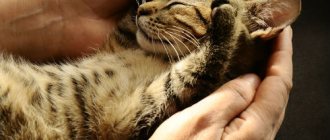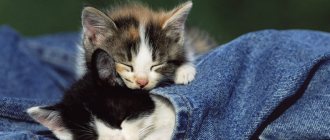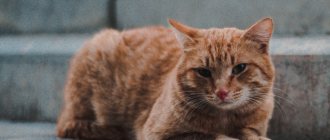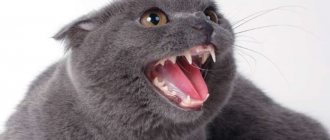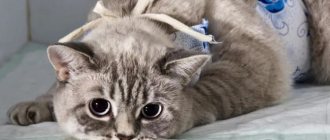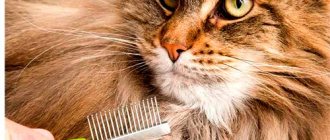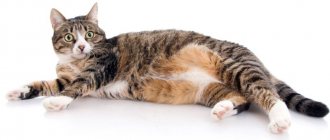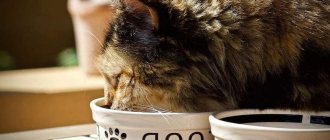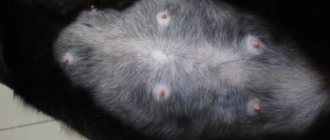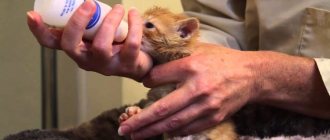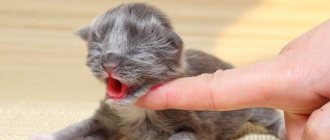Cat paws have always attracted people's attention due to the combination of softness and noiselessness of movement with sharp claws on the fingers. This found expression even in folk art. “Soft paws, with scratchy paws” - this is how the children’s riddle voices the specificity of the limbs of furry pets. But the very structure of the toes on the animal’s paws is also interesting, because cats differ in this regard from other mammals.
- 2 Anomalies in the development of fingers in cats
2.1 Video: a cat with polydactyly
The structure of a cat's paws
The light, dancing gait of cats cannot fail to attract attention. Take a closer look: they walk on their toes, like ballerinas! The cat does not step on its heel when walking, the paw remains collected and rounded, and the sharp claws are securely hidden in special “cases.”
The paw is designed in such a way that every finger and every claw is reliably protected. Between the toes, much coarser hair grows than throughout the animal’s entire body, and the base of the toes is protected by elastic, hairless pads.
Nature has reliably protected cat fingers and claws
Cat's paws are perfection conceived and realized by nature and deserve a separate story. All joints and joints are endowed with extraordinary mobility, which not only ensures graceful movements, but also allows, if necessary, to run very quickly, jump high and far, and perform unimaginable somersaults and pirouettes. The motor reactions of this animal are faster and more accurate than those of any mammal.
Flexible and tenacious fingers allow cats to move on any surface
Fingers are especially flexible - each of them seems to live a separate life, moving, bending and unbending independently of all the others. Thanks to this, cats instantly find balance and stay on almost vertical, uneven, slippery, very risky surfaces.
The cat puts its paw on its toes, the heel remains high above the ground
The famous cat toe-walking is complemented by another gait feature called ambling. All cats are pacers: they alternately move all their right paws, and then the two left ones. This allows predators to confuse their tracks, for secret purposes accurately placing one fingerprint on another. In addition, ambling makes the cat more stable and maneuverable - it makes it possible to quickly develop speed and change the direction of movement.
The pacer cats can walk, accurately following the trail.
Infrequently, but such a congenital pathology as shortened toes on the front or hind legs still occurs. An animal with such an anomaly cannot fully move; in the wild or on the street it will inevitably die. A domestic kitten with underdeveloped toes usually adapts to walking on its own, albeit slowly, with its paws tucked under it. Such individuals, of course, should not give birth to offspring - it is better to sterilize them in a timely manner.
The fingers and claws on the front paws of all cats are designed to catch and hold prey - they are much weaker than the striking hind limbs. However, large predators are capable of inflicting significant damage on their prey with a powerful blow from their front paw. By the way, have you noticed which “hand” your cat uses more actively?
In a fight, all four paws are used - but the back ones are much more dangerous
It turns out that the cat family also has its own right-handers and left-handers. Moreover, cats often prefer the left paw, and males - the right. Accordingly, it is on these “priority” paws that the toes of animals are more developed.
Digestive system
The digestive system includes the pharynx, stomach, oral cavity (teeth, tongue, salivary glands), pancreas, esophagus, gall bladder, liver and intestines. The intestine includes the duodenum, ileum, small and thick intestines. The esophagus begins at the mouth and then connects to the stomach, which consists of special folds. They are needed in order to provide an additional mechanical effect on food.
Subsequently, food passes through the sphincter and enters the duodenum. In it, all food masses are mixed with liver and pancreatic enzymes. When food reaches the small intestine, thanks to the many villi, nutrients begin to be absorbed into the cat's body. After this, the mass is converted into feces, from which moisture is removed in the ileum and colon.
Digestive system of a cat
How many fingers does a cat have?
Only an ignorant person can think that a cat, like him, has two dozen fingers on its “hands and feet.” Nothing of the kind - count for yourself: on each of the cat's front paws there are five fingers (four main and one dewclaw), and on the back paws there are only four fingers. The dewclaw (or false) finger is located separately on the front paw, just above the metacarpus, and is used only on inclined or vertical surfaces.
That is, the total number of fingers is eighteen - two less than the vast majority of other animals. But this is if we talk about ordinary cats. But there are also extraordinary ones - we will talk about them a little later.
An ordinary cat has four primary toes and one dewclaw on its front paw.
Were there any profits?
It is obvious that at the dawn of the glorious cat family, they, like all mammals, had five fingers on all four limbs. However, the cat led such a lifestyle that the fifth toe on its hind legs was not only not used, but also got in the way, which is why it began to gradually disappear in the process of development.
The front paws are a completely different matter. Although dewclaws stand apart from everyone else here, sometimes they help their owner a lot - for example, without them it would be much more inconvenient to climb trees.
If on the front paws the dewclaw is clearly visible, then on the hind paws there is no trace of it left.
If we draw an analogy with dogs, then puppies are often born with underdeveloped false toes on their hind legs. To avoid injury, they are removed for babies in the first days or even the first hours of life. The only exceptions are some breeds where the hindquarters are a sign of the standard (for example, Briards and Pyrenean Mastiffs).
In cats, evolution has advanced further, and such a rudimentary manifestation is almost never observed in newborn kittens. On the metatarsal bones of the hind limbs, only a barely noticeable hint of the fifth toe remained.
Internal organs
The internal structure of a cat is a set of all the same vital systems that are inherent in other mammals. Let's look at them in order.
Circulatory and respiratory systems
The circulatory system of a cat is not particularly different; the animal's pulse at rest ranges from 100 to 150 beats per minute and can be measured by pressing the femoral artery. Normally, blood in an animal’s body should be approximately 7% of its mass; cat blood is specific and clots faster than human blood.
With each beat, a cat's heart pumps about 3 ml of blood. The blood circulation of a cat occurs similarly to that of a person: in the lungs the blood is saturated with oxygen, and in the digestive organs with useful substances. After which the heart carries fresh blood through the arteries to all organs. And through the veins, blood flows back to the heart so that it again sends it to the lungs to be enriched with the necessary oxygen.
The respiratory system, in addition to supplying the blood with oxygen, is also involved in thermoregulation. The breathing rate in cats is 20-30 breaths per minute, in kittens about 40 breaths, and inhalation is through the nose. The air inhaled by a cat through the nose is first warmed and filtered, then passes through the pharynx into the larynx, trachea and lungs of the animal. There is an assumption that a cat makes purring sounds using pocket-like folds that are located in the larynx.
Excretory and digestive systems
The cat's digestive system also has much in common with humans. It begins with the mouth and ends with the rectum and sphincter. Between them are the pharynx, esophagus, stomach, small and large intestines. The pancreas and liver are also considered components of the digestive system.
It is noteworthy that the cat's stomach can digest fairly large pieces of food, which the cat bites off thanks to its strong and sharp incisors and fangs. The cat's intestine is approximately 3 times longer than the animal's body and is 1-1.8 m. The cat also has a cecum, but the murka does not have an appendix.
Fluid is removed from the cat's body through the urinary system - the kidneys, bladder and ureters. Urine formation begins in the kidneys, which also regulate blood chemistry. Urine then moves into the bladder through the ureters, from where it is removed from the body. The process of urination occurs under the control of the closing muscle, which prevents spontaneous urination. The following video will help you understand the structure of a cat by literally looking inside the cat's body!
Reproductive system
The purpose of the reproductive system is obvious - it is the continuation of the cat family. A cat's reproductive organs are the gonads, testicles, vas deferens and penis. In a cat, these are the ovaries, uterus, oviducts and external genitalia. The time for male cats to reach puberty is 6-8 months, however, the safe age for mating, when full-fledged offspring can be expected, is at least 10 months. During puberty, the behavior of cats changes greatly and they show in every possible way their readiness to reproduce.
What is polydactyly
The standards for the vast majority of domestic breeds call the general norm for a cat to have eighteen toes. But there are exceptions to the usual rules - cats with many toes. Denoting a fairly common genetic mutation, the word “polydactylism” consists of two Greek words: “poly” is translated as “many”, and “dactylos” is translated as “fingers”; This phenomenon is also called hyperdactyly. With polydactyly, one paw can have up to seven toes, and sometimes even more.
Polydactyly in cats is a harmless but very unusual mutation.
Most often, the mutation appears on the front legs, somewhat less often - on all four limbs, and most rarely - exclusively on the back legs of the cat.
Polydactyly is inherent in almost all animals and even humans, but in the cat family this strange phenomenon occurs most often. If one of the parents is polydactyl, then the probability of giving birth to “polydactyl” kittens reaches sixty percent.
Postaxial polydactyly makes a cat's paws stable in the snow
There are two known varieties of feline polydactyly, which in the slang of felinologists are called “mittens” and “snowmobiles”. Postaxial polydactyly - when additional fingers are aligned with the main ones. This helps the animal easily move through deep snow without falling into it - that’s why these cat paws are called snowmobiles. And with preaxial polydactyly, the extra fingers grow as if separately from the rest. At the same time, the cat's paw really resembles a funny mitten.
Preaxial polydactyly - these paws really look like mittens
There are also examples of “reverse” mutation - hypodactyly, which, unfortunately, is not as harmless as polydactyly. Kittens that at birth had fewer than the standard eighteen fingers rarely survive to adulthood: they usually have pathologies or severe underdevelopment of the liver. The gene mutation that causes hypodactyly activates the so-called “junk” genes, which provoke the development of dangerous pathologies in the cat.
Video: polydact - a cat in mittens
Extra fingers - where and why?
Multi-toed cats have been known for a very long time - they live with humans for as long as our domesticated feline community has existed. According to the scientific definition of geneticists, manifestations of polydactylism are inherited as an autosomal dominant trait of the Pd gene with incomplete penetrance.
Does this cause discomfort to the cat? Judging by appearance alone, one would think that polydactic cats must have a very difficult time moving around. In fact, this is completely wrong. Since the anomaly is congenital, the “special” kitten perceives it as a completely natural state of affairs and does not spend any effort to adapt. True, breeders note that such babies take a little longer to learn to walk than their usual 18-toed littermates.
Multi-toed kittens start walking a little later than their “standard” littermates.
The paws of such animals are much more stable when walking on various difficult surfaces, and when hunting, a couple of additional claws are never superfluous. According to an old legend, in difficult times of hunger, multi-toed Maine Coons even learned to catch fish in order to give it to their owners for food.
Video: the more fingers, the more convenient it is to play
Record holders for the number of fingers
It is difficult to name a clear record holder for polydactylism. Recently, the popularity of polydact cats has been growing rapidly throughout the world, and there are quite a few examples of individuals with seven toes on each paw. According to some reports, there was a Mickey Mouse cat whose total number of fingers reached 32 - it was reported back in 1974, but there is no official confirmation of this phenomenon.
Sometimes polydactyly is confused with another congenital mutation - polymelia, in which additional fingers appear due to an extra limb fused to the main one. Most likely, the cat Mickey Mouse had just such a pathology.
There are 8 toes on the paw; if everyone else has the same amount, then this cat is the undisputed record holder
Polydactyly, to one degree or another, can occur in both purebred and outbred cats. But this hereditary mutation is most often observed in breeds of North American origin - especially the multi-toed Maine Coons. It has been noticed that animals with polydactyly have more powerful bones - their chest is wider and their front legs are thicker than those of ordinary littermates.
Video: polydactyly or polymelia?
Multi-toed cat breeds
The American polydactyl cat is an indigenous North American breed, about the origin of which scientists do not have a consensus - only versions. Only the historical homeland of the American polydactyl cat is known for certain - the state of Massachusetts. Polydactyl cats, semi-wild and tame, have lived here since time immemorial and were famous for their success in catching mice.
Attempts to form a breed based on indigenous individuals began at the end of the nineteenth century, but were scattered and unsystematic. As a result, the American polydactyl cat has remained unrecognized by authoritative felinological organizations to this day.
The American Polydactyl Cat is an unrecognized breed of aboriginal origin.
Some breeders claim that forty percent of Maine Coon kittens in their catteries are born multi-toed. For a long time, such babies were discarded or sterilized, not allowed for breeding. But the breed's potential takes its toll - polydactyly is embedded in the genetics of Maine Coons.
Initially, this feature helped the native North American breed survive the harsh winter: it is easy, like on skis, to move through snowdrifts and effectively obtain food for itself. In the summer, polydactic giants successfully used their extra fingers to climb trees and catch fish.
Multi-toed paws help Maine Coons not to fall into deep snow
Recently, some mustelid nurseries have begun to purposefully breed polydacts. This bold undertaking was initiated by reputable breeders from Holland and Belgium - they are striving to recognize the multi-toed Maine Coon as a new breed, at least in experimental status at first. And recently, the American Maine Coon Breeders Association (MCBFA) developed a standard for a new breed line; Registration of polydact cats is carried out by such US felinological organizations as CFA and TICA.
Video: multi-toed Maine Coon from Omsk
The Pixie Bob (or Short Tail Elf) is the only internationally recognized breed that is officially fully polydactyly according to its standard. In the section of the breed standard that describes the pixie-bob’s paws, it literally says: “Polydactyly is allowed, with a maximum of seven toes.”
The Pixie Bob is the only breed whose standard welcomes polydactyly.
The extra toes perfectly solve the problem of evenly distributing the load on the paws, because the body of the short-tailed elf is extremely massive and muscular. Thanks to them, even the largest cats can run, jump and play with amazing ease.
Multi-toed representatives of this breed are valued several times higher than ordinary ones. Of course, there is no direct relationship between the number of toes on the paws and the price, but purebred, polydactic kittens that meet the standard can cost ten thousand dollars or even more. Multi-toed pixie bobs are also highly appreciated by experts at exhibitions.
Video: short-tailed elf with six fingers
Responsible breeding work is required to eliminate from breeding individuals suffering from radial hypoplasia, a rare anomaly that can accompany polydactyly. With this genetic disorder, the cat's paws are weakened, and the extra toes are fused, resulting in the animal being disabled.
Interesting Facts
Immediately after the discovery of America, the multi-toed cats discovered there had their eyes set on... by sailors. Thanks to them, most likely, polydacts came to Europe. Sailors believed that such cats brought good luck and were especially valued for their paws that were stable when rocking and their hunting talents - extra fingers and claws were very useful in the fight against ship rats and mice. The term “ship cats” originates from here.
A multi-toed cat on a ship brings good luck
In Medieval Europe, polydacty cats were subjected to brutal extermination during the troubled times of the “witch hunt.” Extra toes on a cat's paws were perceived by the Inquisition as a clear sign of the devil.
One of the first cats to live in the White House was Slippers, the favorite of US President Roosevelt. Slippers, who belonged to the American polydactyl breed, was distinguished by his intelligence and regal demeanor and often graced various official events with his presence. Interestingly, slippers translates from English as “slippers” - a great name for a multi-toed cat!
President Roosevelt and his beloved cat Slumpers - they have something in common, don't they?
Polydacts are sometimes called "Hemingway's cats." It turns out that the great writer Ernest Hemingway loved cats - about fifty of them lived on the territory of his estate in Key West. And the clear favorite of “old Ham” was the cat Snowball, who had six toes on each of her front paws. Now in Key West, where the writer’s house-museum is located, there are at least sixty cats and cats on board, most of them polydactics; these are the descendants of the famous Snowball.
Ernest Hemingway loved cats
Photo gallery: multi-toed cats and kittens
The Canadian polydactic cat Plohish got his name for his special ingenuity in pranks. The famous Tiger cat is a representative of the American polydactyl breed, he has 27 fingers
Maine Coon Polydact Samba is the most famous cat of Samara
A California woman discovered a litter of multi-toed kittens in her garage.
A kitten named Wallace was dropped off at a Portland veterinary clinic.
Brain and endocrine system
The brain can be briefly described as a gray-pink nervous tissue that has 3 main parts:
- Head brain.
- Brain stem.
- Cerebellum.
Sections of the Brain
The mustache brain consists of a billion neuron cells that are connected to another 10,000 other neurons.
The endocrine system is responsible for the release of special hormonal secretions. Thus, the endocrine system normalizes the functioning of all organs; it consists of:
- pituitary gland;
- hypothalamus;
- liver;
- kidneys;
- pancreas;
- adrenal glands;
- ovaries and testes;
- liver;
- parathyroid glands;
- part of the gastrointestinal tract.
Endocrine system
How to care for cat paws
All cats instinctively take great care of their paws, and the owners’ task is to help them do this as much as possible. Even a very minor injury - a scuff, crack or scratch on the pads of the fingers can greatly unsettle your pet: he will become irritable or, conversely, depressed, and lose his appetite. In addition, wounds in this area are extremely painful, and sensitive cats suffer greatly from them.
The causes of injury to the pads of the paws and fingers can be very different:
- physical - cuts from sharp objects at home or while walking;
- thermal - cats often get burns by jumping, for example, on a hot stove, and in extreme cold, frostbite occurs on their fingers;
- chemical - if an animal walks in the snow in winter, then the substances that are sprinkled on it may cause a chemical burn on the foot;
- improper nutrition - unbalanced, poor-quality feeding leads to cracking of the skin on the pads and the appearance of weeping ulcers.
Even a minor finger injury can have serious consequences.
Some skin and internal diseases or severe stress can also negatively affect the condition of cat fingers. Such problems require diagnosis and comprehensive treatment under the supervision of a veterinarian.
To eliminate the problem, you need to identify its cause in a timely manner, and for this you should periodically carefully examine your pet’s paws. And at the slightest violation of the skin on the pads and fingers, immediately wash and heal the wounds. It is also very important to constantly monitor the condition of the claws - make sure that they do not grow too long, do not split or get injured.
Trim your cat's claws promptly
An excessively overgrown claw or neglected injuries are common causes of inflammatory processes, which in some cases can even lead to amputation of a finger.
If your cat does not wear down her claws naturally, she will need to have her nails done by herself or by a veterinarian as they grow back. To prevent your pet from damaging upholstered furniture and wallpaper with its claws, just buy him a good scratching post or make one yourself from scrap materials - it’s not difficult at all.
Buy your cat a good scratching post
In polydactic cats, the claws on the “extra” toes grow at a faster rate than on regular toes. This must be taken into account in order to adjust their length in a timely manner.
Video: DIY scratching post - it's easy
What causes profuse sweating?
Excessive sweating is not typical for cats, so if this symptom appears, the owner should be wary. It can be a sign of both exposure to unfavorable factors and pathological conditions.
Diseases
When an owner notices that their pet is leaving wet marks more than usual, this may be a warning sign for them. Excessive sweating in your pet can be a symptom of various diseases. First of all, those associated with increased temperature:
- hemobartonellosis - an infectious bacterial disease that affects blood cells;
- feline AIDS, a viral disease that suppresses the immune system;
- viral leukemia - a disease associated with suppression of bone marrow functions;
- flu;
- infectious peritonitis, a fatal infection that attacks the immune system of cats;
- upper respiratory tract infections;
- panleukopenia - “distemper”, a viral disease that affects many systems of the cat’s body;
- toxoplasmosis is an infection caused by microscopic parasites.
Naturally, each of these pathologies is accompanied by a number of other symptoms. However, primary signs, which include profuse sweating, are prerequisites for urgent contact with a veterinarian.
Stress
In addition to illness, excessive sweating can cause stress. Most often, this condition is provoked by factors that irritate the nervous system, causing changes in the functioning of organs.
Stress can be short-term or it can last for a long time. Short-term stress most often passes painlessly. If an animal is stressed for a long time, then a malfunction of some system (for example, a thermoregulation system) or a disease occurs.
Causes of stress can be:
- physical damage, such as burns or injuries;
An injury to a cat is a stressful situation for it, especially if it is accompanied by long-term treatment.
Overheat
As the weather gets hotter, many cats may suffer from overheating. This condition may result in dysfunction of thermoregulation. A cat's body temperature can rise to 41 degrees. Signs of pathology are always clearly expressed. Prolonged overheating can be fatal. Those most susceptible to heat stroke are:
- kittens;
- pregnant cats;
- older animals.
These categories of animals are at risk because their bodies are weakened due to age or physiology. Also at risk are cats whose breed suggests a brachycephalic skull structure. In cats with a shortened muzzle, heat exchange processes are worse. This becomes a reason to pay closer attention to pets during the heat.
Cats with very long hair or thick undercoat are also at greater risk of heatstroke than others. Signs of overheating include:
- unnatural spread-eagled pose;
- breathing through the mouth with the tongue sticking out;
A cat breathing with its mouth open is a sign that the animal is overheating.
I first observed overheating of an animal in my Thai cat. We lived in an apartment, but often went for walks together; she walked perfectly on a harness and even without it, not lagging behind me more than 4-5 steps. Not far from the house there was a forest and a meadow. And then one autumn (Indian summer) we went for a walk. The sun was shining and the weather was beautiful. About twenty minutes later, the cat began to leave the path and lie down in the thickets of grass on its side. I chalked it up to being tired; after all, we didn’t go for walks every day, and at home the animal had virtually no conditions for physical exercise. I gave her a few minutes of breathing space and then moved on. My “faithful dog” got up and followed me. And then I saw that the cat opened its mouth, stuck out its tongue and began to breathe heavily. I didn’t know how dangerous this condition was, but out of compassion for the animal, the walk ended there; the pet got home in my arms. Only later did I find out. that a cat's breathing is a sure sign of overheating, not fatigue.
Deviations from the norm
Deviations from the norm in the development of cat fingers are a common occurrence. Polydactyly in cats is called polydactyly (from Greek: poly = many, daktulos = fingers). The record number of toes on a cat's paws was recorded in October 1974 - as many as 32 toes!
Polydactyly can be postaxial or preaxial. With postaxial polydactyly, the fingers are arranged in one row. With preaxial, additional toes grow on the inside of the paws.
The first record of feline polydactyly dates back to 1868. Cats with this feature quickly gained attention and interest. Sailors fell in love with polydact cats and took them with them on their trips. It was believed that the six-fingered fluffy traveler would bring good luck to the ship and protect it from sea troubles. In addition, the sailors believed that the many-toed cat would make a good rat hunter.
Multi-toed cats are sometimes called ship cats
Cats with polydactyly are called Hemingway cats. The house of the famous writer was filled with fluffy purrs, among which was a six-fingered cat. And Theodore Roosevelt's polydactyl favorite became one of the first cats to live in the White House.
A haircut
Unlike their wild relatives, modern pets lead a less active lifestyle and do not have time to wear them down. They constantly grow back and even a scratching post is not effective.
The fifth toe on the front paws is especially dangerous; it is located higher than the rest and the claw is too long and can begin to grow in or prick the paw pads, causing pain. In addition to its own discomfort, the pet can cause damage to furniture or scratch its owners.
You can tidy up your animal’s paws yourself if you have the skills to use special scissors.
Before starting the procedure, carefully examine the paw and claws; their ends are light and the base is dark - the pulp. It contains blood vessels and cannot be touched, much less cut. It bleeds blackish and can cause inflammation.
The circumcision process itself is painless, but some cats become nervous and even show aggression. Therefore, sometimes it is better to carry out manicure procedures together, so that one holds the pet and the other cuts the hair.
When trimming your nails, follow these guidelines:
- To begin, take the cat and calm it down, pet it, talk to it. Place him on your lap. Take the paw in your left hand (for right-handers), fix your pet’s finger between your thumb and forefinger, lightly press on the pad and a nail plate will appear;
- Determine the area of the nail from the pulp, it should be a light tip;
- The nail clippers should be positioned perpendicular to the nail and cut off the claw in one motion. If you place them parallel, this can lead to delamination of the plate;
- If sharp corners have formed, they can be cut off with a regular manicure file;
- All other claws should be trimmed using the same principle.
After completing the process, treat your pet with a treat so that he remembers and will not be nervous next time when grooming.
The veterinarian will cut the hair correctly and clearly show it. After that you can try it yourself. If you are not confident in your abilities, then contact your doctor once a month to repeat the procedure.
Nowadays, many attributes have been invented for animals, but if your pet damages furniture or gets scratched badly when playing, you can put silicone attachments on its claws. Safe and does not cause discomfort to the pet. True, if the cat doesn’t like it, he can make an effort and remove them.
Some owners use complete declawing to preserve furniture and expensive coverings in the house. This is a huge stress and health hazard for the animal.
The importance of maintaining healthy nails
It is important to maintain your pet’s claws in good condition, as a lot depends on it. If you don’t want your pet to spoil carpets and furniture, be sure to purchase a scratching post. This simple device can save you a lot of nerves.
In the simplest case, you can make a homemade “sharpener” by taking a small piece of wood and wrapping it tightly with rope. Why are claws so important for an animal’s health? If they grow too large, the pet will experience severe pain. Because of this, the cat will become less active, lose its appetite, and become exhausted.
The secret of joints
The cat's four limbs serve more than just walking and running. Their unique structure allows the animal to overcome rough terrain, climb slopes and jump perfectly easily, all while being almost silent.
The joints of a cat's paws have a unique feature: when walking, they rotate and turn in different directions absolutely freely, which allows the animal to move so easily on different surfaces, be it a tree or a flat floor.
The front paws move inward when walking, forming a straight line of tracks from the front to the hind paws.
History of Maine Coon mutations
Thanks to the closed habitat, the mutation spread for generations to come. The multi-fingered cat looks harmonious, its bones are strong, it does not seem dry and thin. Her movements are normal, and breeders note strong joints and ligaments. Care is the same as for other cats.
Sailors recognized such coons as capable of hunting deck rodents. The unusual appearance has always attracted people and contributed to the creation of mythical stories. There is an opinion that a Maine Coon with extra phalanges brings happiness, and this is so necessary when traveling on ships.
Useful to read: American Maine Coons - the Pied Piper from Maine
The first cat in the US White House belonged to Theodore Roosevelt. She had extra phalanges, and her name was Slipper. The genes themselves probably appeared due to a random mutation, since they do not cause harm. In humans, limb abnormalities can occur not only for hereditary reasons.
